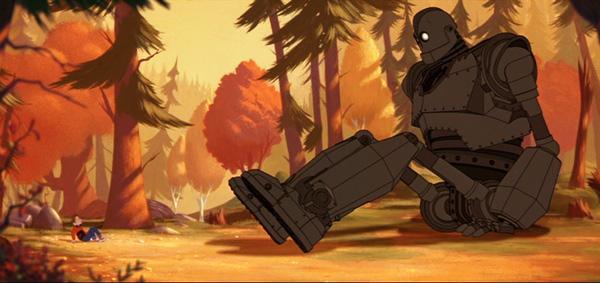
Near a small American town, during the Cold War, something falls from the sky. It’s not widely noticed, and most speculation as to its nature is written off as crackpot theorizing. But soon afterwards, a young boy encounters and befriends the extra-terrestrial visitor to our world, and defends him from the fearful forces that only see it/him as a threat.
You could certainly be forgiven for mistaking the plot summary of The Iron Giant with that of E.T., but Brad Bird’s animated delight stands on its own two feet and can certainly hold its own against any other film that mines this archetype of the lonely boy who befriends a foreign stranger.
Hogarth Hughes, the boy who discovers the giant alien robot, is quite unusual in the canon of young male protagonists in American animated films. He doesn’t live in a distant, exotic past or locale. He doesn’t have any spectacular powers or skills. But the qualities that do set him apart are his intelligence, imagination, inquisitiveness, and sympathy. In spite of his likability, he’s clearly a lonely child, fatherless and misunderstood by his classmates, and the film’s subplot of the development of his friendship with a beatniky artist/junkyard manager named Dean makes an interesting foil to the main plot of his friendship with the giant.
That relationship between Hogarth and the giant is the film’s focal point; there is a lot of comedic mileage in his efforts to keep its existence, whereabouts, and nature secret from the US government, represented mainly by Agent Mansley, a consummate bureaucrat who is as incompetent as he is infatuated with his own significance as an agent of the Federal government.
Mansley’s idiocy certainly contributes to his villainy as he tracks down the giant, but the film also goes out of its way to put his actions in the context of the paranoia of the Cold War. It’s the Fall of 1957, Sputnik is in the newspapers, cheerful duck-and-cover films play at Hogarth’s school, and one of his comic books is entitled Red Menace. Progressive revelations about the giant’s capabilities and purpose further muddy the moral waters of the actions taken against the giant. This level of texture in the characterization of the villains is one of the qualities of the film that elevates it above other children’s animated movies, as well as live action films that explore similar territory (such as E.T.).
In a film like this, it would be remiss not to discuss the quality of the animation. Brad Bird uses a clean-line animation style that emphasizes quality of motion and expressiveness over texture and detail, especially in the characters. Backgrounds are also often rendered in this style, but sometimes, especially scenes depicting the Maine forests in their autumn beauty, a much more lush and detailed technique is used. This is entirely appropriate in light of the significance of the giant’s encounters with beauty and nature.
As I have hinted, the giant is not simply harmless and misunderstood; he does indeed hold a good deal of menace just under the surface. One of the greatest joys in the film is to see how the power of stories and relationships influence the giant and how his insistence that “I am not a gun” plays itself out in the film’s climax.
The Iron Giant might not bring much new to the table, but the dishes it does lay out are so thoughtfully and appealingly prepared that one cannot help but enthusiastically enjoy the feast.
—Scott Cunningham
—Steven D. Greydanus
- Directed by: Brad Bird
- Produced by:
- Written by: Brad Bird Chris McCanlies
- Music by:
- Cinematography by:
- Editing by:
- Release Date: 1999
- Running Time: 86
- Language: English
Arts & Faith Lists:
2011 Top 100 — #99